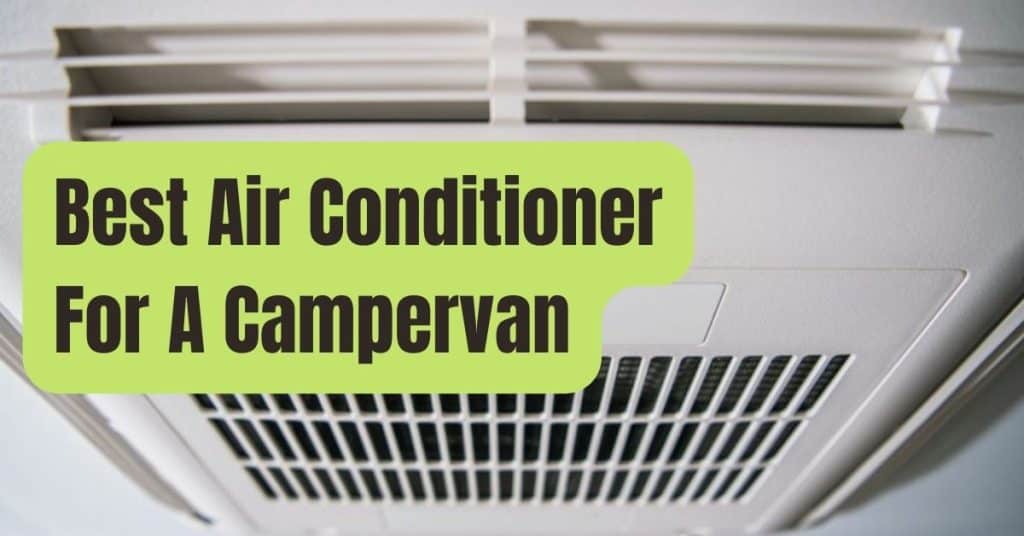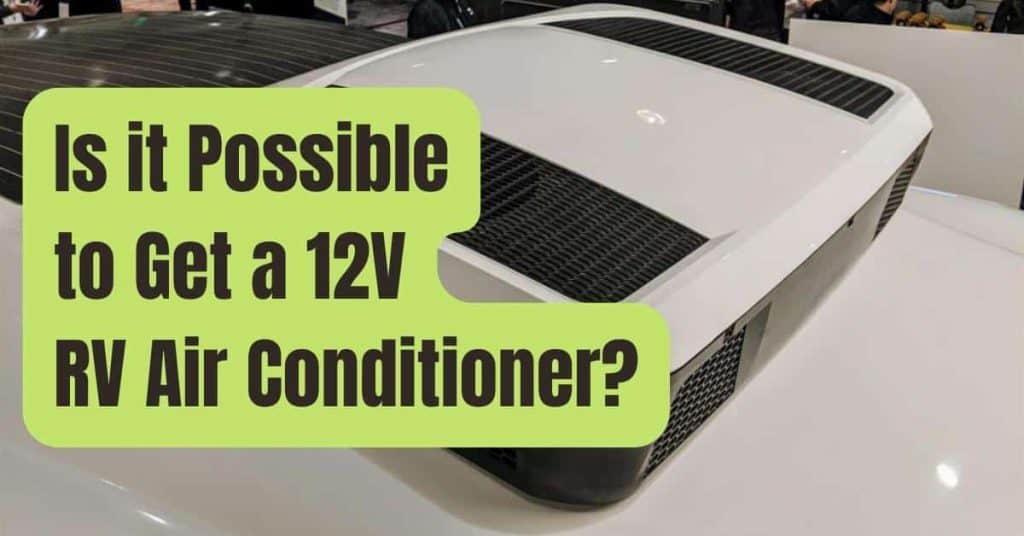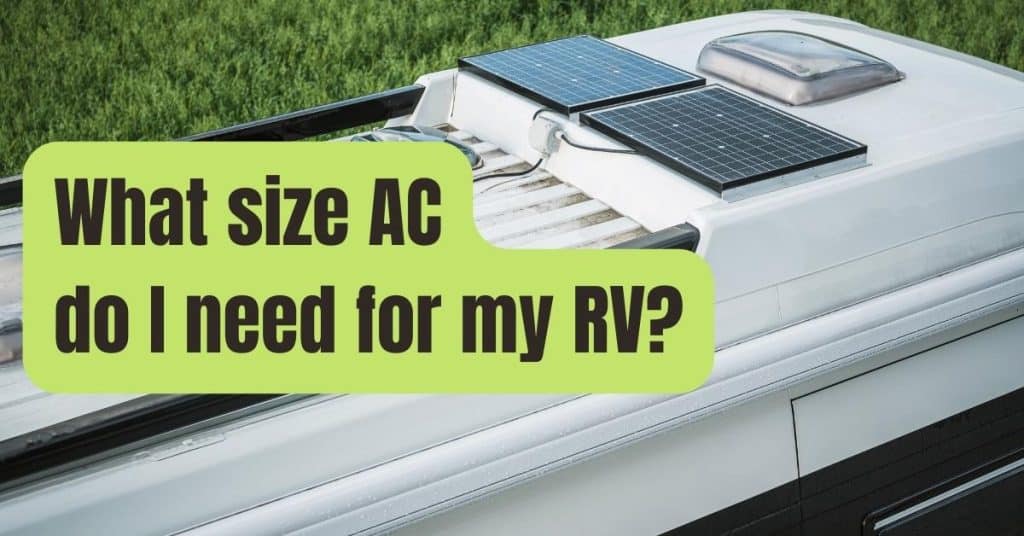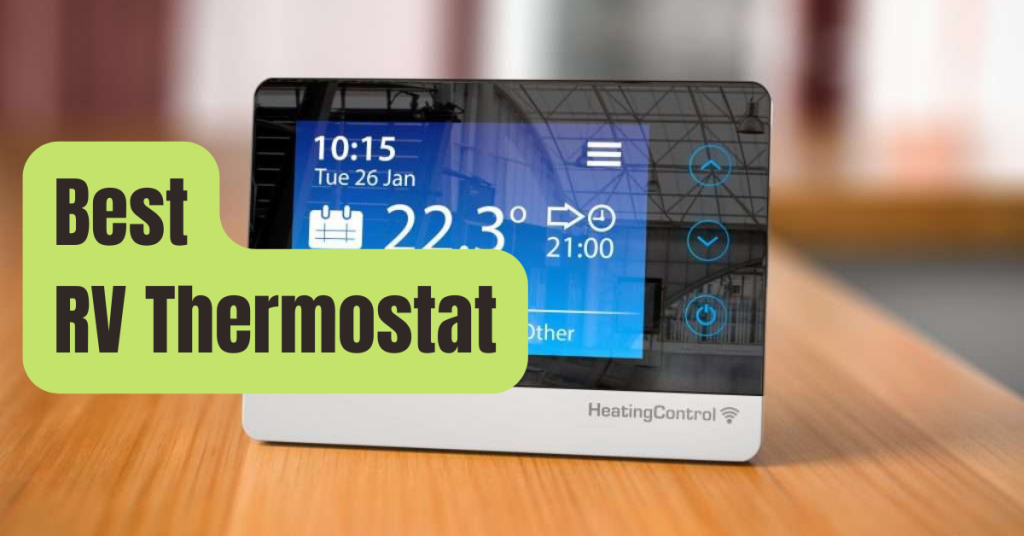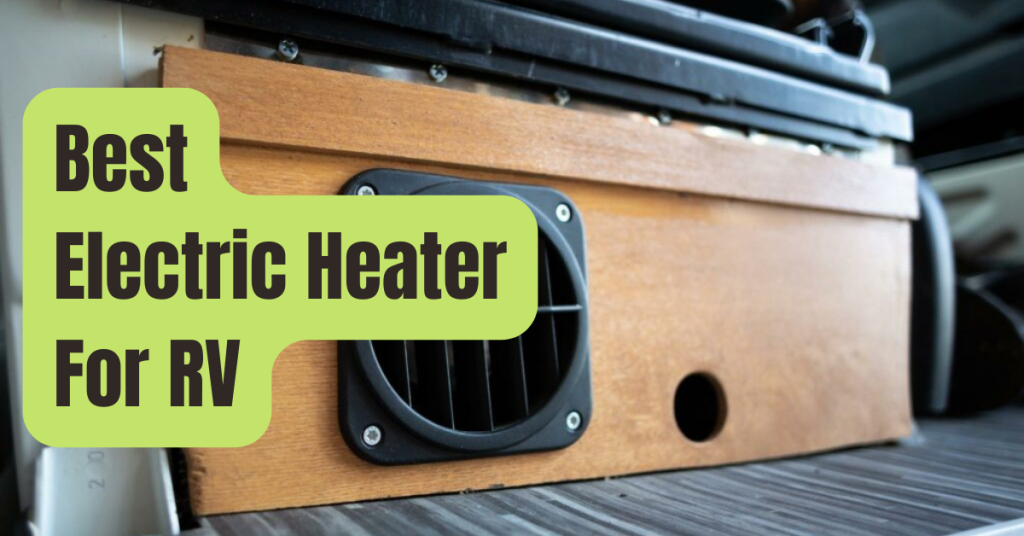There are a lot of different factors to consider when purchasing an RV air conditioner. Size, BTUs, and price are all important, but there are also other features you may want to look for when making your purchase. The best RV Air Conditioners on the market today vary in size, BTUs, and price, so it’s important to do your research before settling on one.
Keeping cool in your RV or camper during the warmest months of the year might be difficult.
It’s much more difficult if you don’t have the proper technologies in place to keep the interior cool while the outside temperature rises.
Whether you need to replace or update your current RV air conditioner, you’ll want to start your search with the top RV air conditioner alternatives available today.
But how are you going to go through the whole market in order to cut down your options?
Fortunately for you, you’ve arrived to the correct location today. You’ve arrived here after completing the first step of a targeted Google search.
And we’ve already done all of the legwork for you, so you can spend less time looking for a new RV air conditioner for your RV, camper, or travel trailer.
The greatest thing is that you won’t have to walk into an outlet shop or showroom to ask all of these questions to a salesman.
In this guide to the best RV Air Conditioner, we’ve compiled everything you need to know so you can choose the finest air conditioner for your rig and your needs right now.
Our Top Picks for The Best RV Air Conditioners in 2025
- Dometic Brisk II (B59516.XX1J0) Rooftop RV AC Unit is the best overall.
- Furrion FACR14SA-PS Rooftop RV Air Conditioner has the best vibration resistance.
- Airxcel 08-0080 Arctic 15.0 Rooftop Camper AC has the largest fan motor.
- Dometic Penguin II 20 Amp Low Profile Rooftop RV AC is the best low profile RV Air Conditioner.
- Airxcel 472038876 Mach 8 Plus Camper AC is the best tiny RV Air Conditioner.
- Honeywell MN12CESBB Portable Multipurpose AC is the best portable RV Air Conditioner.
- Dometic Blizzard Nxt RV AC With Heat Pump: Best For Multizone Use
- Dometic Penguin II 651816 AC with Heat Pump is the best choice for dual use.
8 Best RV Air Conditioners Reviews and Recommendations
Which RV Air Conditioner Is the Best? The fact is that there is no one size or kind of RV air conditioner that will meet your demands.
When looking for the finest air conditioning equipment for RVs or campers, there are a few things to consider.
One is an energy-efficient unit, which can help you save money on your energy bill while also lowering the temperature in your house. Then decide on the size of the air conditioner, making sure it fits in the given area.
Last but not least, there are BTUs (British Thermal Units), which indicate how much room a unit can chill (the higher the BTUs, the more square feet it can cover).
With these considerations in mind, our top RV air conditioner picks are suitable for RVs, travel trailers, 5th wheels, and even camper vans.
However, you should pay careful attention to what we liked and didn’t like about each of these models so you can begin limiting down your options!
Our top 8 selections for the finest RV air conditioners for your rig and camping style are as follows:
#1. Dometic Brisk II (B59516.XX1J0) Rooftop RV AC Unit is the best overall

Because it can be placed on ducted or non-ducted RV AC systems and has a 15,000 BTU rating for cooling RVs with up to 750 square feet of inside space, we rated the Dometic Brisk II Rooftop AC as the best overall RV AC.
This RV air conditioner boasts a high-performance motor and fan, as well as a 115-volt AC power rating.
This is a full-height rooftop RV air conditioner that operates quietly and has a heat pump so you can use it for both heating and cooling.
The Dometic Brisk II is intended for use in RVs equipped with single-zone thermostats.
As a result, it will not work for big rigs with multi-zone thermostats.
However, since the motor, compressor, and evaporator are all bracketed together to avoid vibrations while it’s operating, it’s quieter than some other AC units.
Another aspect I enjoy about this AC unit is that it has an all-new base pan that minimizes overall weight so it doesn’t create a lot of drag to your RV.
Other re-engineered features on this RV air conditioner help it weigh 19 percent less than prior versions while delivering 15% more airflow.
We Love
- With a 15,000 BTU rating, this air conditioner can effectively cool up to 750 square feet.
- This RV air conditioner comes with a heat pump, allowing you to use it for both heating and cooling.
- It may be put on both ducted and non-ducted vent systems, making it quite versatile.
- Quiet Operation: The interior components of this RV air conditioner unit have been designed to prevent vibrations while in use.
We’re Not Fond Of
- Single-Zone Operation: This AC unit will not function in RVs with multi-zone thermostats.
- Price: You get what you pay for, but this isn’t the cheapest air conditioner on the market.
#2. Furrion FACR14SA-PS Rooftop RV Air Conditioner has the best vibration resistance

If quiet and vibration resistance is your top priorities, the Furrion Chill FACR14SA-BL RV Rooftop AC is our pick for the finest quiet and vibration-resistant air conditioner for RVs.
This is one of the few RV air conditioners featuring VibrationSmart Technology on the market.
This technique guards the internal components of the air conditioner from harm caused by severe vibrations.
However, since it lowers general vibrations, it also lessens the unit’s overall noise production while it is in operation.
This silent RV air conditioner also has Furrion’s unique ClimateSmart Technology, which enables it to run effectively in even the harshest weather conditions.
It’s also 40% more energy efficient than comparable single-fan versions on the market.
The Furrion Chill has a 14,500 BTU rating, which means it can chill areas up to 725 square feet effectively.
Furthermore, since this is a full-height rooftop AC unit, it generates less than 80 decibels of noise.
We Love
- Vibration Resistance: This unit’s vibration-resistant construction reduces noise and protects internal components.
- ClimateSmart Technology: This device is also built to work in more harsh weather conditions.
- Electricity Efficiency: The ‘Chill’ uses up to 40% less energy than competing single-fan air conditioners.
- BTU Rating: With a 14,500 BTU rating, this device can cool areas up to 725 square feet.
We’re Not Fond Of
- Energy Consumption: This item is rated to use 1,650 operating watts and 3,450 beginning watts, thus it might need a lot of power.
#3. Airxcel 08-0080 Arctic 15.0 Rooftop Camper AC has the largest fan motor

If the size of your AC unit’s fan motor is the most important factor to you, the Airxcel 08-0080 Mach 15 AC unit is a good choice.
This unit’s 13-horsepower fan motor is one of the industry’s biggest, allowing air to move more evenly and effectively throughout your RV.
This unit has a 15,000 BTU rating, which means it can adequately chill rooms up to 750 square feet.
The inbuilt electric heating element with a capacity of 5,600 BTUs in this huge RV air conditioner may also be used to provide heat.
This device works best in RVs that have ducted heating and cooling systems.
It has a maximum airflow of 325 cubic feet per minute and needs a 115-volt AC power connection to operate.
It’s also worth mentioning that while cooling on high, this AC unit will consume slightly under 15 amps.
This unit’s operating wattage changes based on where it’s being used.
For example, although it needs 1,560 conventional operating watts, in a desert area it may require up to 2,025 running watts.
We Love
- The 13-horsepower fan motor on the camper air conditioner unit is one of the biggest in the industry.
- Heating and Cooling Capabilities: This air conditioner also has an electrical heating element that can be used to keep your RV warm during the colder months.
- Airflow: This device can provide 325 cubic feet per minute of airflow.
- BTU Rating: This AC unit, like many of the others on our list, has one of the highest BTU ratings on the market.
We’re Not Fond Of
- Compatibility: Keep in mind that this RV air conditioner is meant to work with a ducted air conditioning system.
#4. Dometic Penguin II Low Profile Rooftop RV AC is the best low profile RV air conditioner

Look no farther than the Dometic 640315CXX1J0 Penguin II Low Profile Rooftop AC if you’re seeking for a low-profile rooftop RV air conditioning unit.
With a height of less than 10 inches, this air conditioner has a sleek design. This height reduces drag and increases the fuel efficiency of your RV.
It also has a 13,500 BTU rating, which means it can adequately cool RVs with up to 675 square feet of interior area.
It may also be used with ducted or non-ducted air conditioning systems. It includes easy-to-reach controls on the ceiling component for the latter.
You may change the temperature at which the RV AC unit turns on, as well as the speed of the internal fan motor, using these settings.
If you do decide to use it with a ducted air conditioning system, it will connect straight to your wall thermostat, allowing you to select your preferred fan and temperature settings.
This RV air conditioner also includes a pre-installed module board and heat strip to make installation in narrow RV ceilings simpler.
On the highest fan setting, it produces 320 cubic feet per minute of airflow.
We Love
- Low-Profile Design: With a height of less than 10 inches, it is the industry’s shortest.
- This rooftop RV air conditioner may be used with ducted or non-ducted RV systems.
- Easy Installation on Thin Ceilings: This camper air conditioner has a pre-installed module board and heat strip to make installation on thin ceilings a breeze.
- BTU Rating: With a BTU rating of 13,500, this unit can cool rooms up to 675 square feet.
We’re Not Fond Of
- Low Profile: While low-profile AC units save money on gas, they are noisier than full-height counterparts.
- Price: While you’re getting a high-quality air conditioner, this isn’t the cheapest model on our list.
#5. Airxcel 472038876 Mach 8 Plus Camper AC is the best tiny RV air conditioner

If you’re not convinced on the Dometic Low Profile AC we evaluated above, the Airxcel 08-0214 Mach 8 Plus camper AC unit is our top selection for the best tiny rooftop RV air conditioner.
On its highest fan setting, this camper air conditioner type produces a maximum airflow of 300 cubic feet per minute.
This compact RV air conditioner has a maximum BTU rating of 13,500, which is adequate to cool RVs up to 675 square feet.
The Mach 8 Plus is also a relatively light AC unit, weighing in at around 55 pounds and measures 45″ x 32″ x 14″ in size (length x width x height).
This device works with a 115-volt AC power source and comes with or without a condensate pump for more humid conditions.
In addition to providing great strength and longevity, the AC’s distinctive fiberglass base pan helps to reduce the unit’s total weight.
We Love
- The AC’s unusual fiberglass base pan contributes to its overall weight being under 55 pounds.
- The 13,500 BTU rating of the unit enables it to effectively cool RVs up to 675 square feet in size.
- Compact Dimensions: Because of its modest size, this unit is suitable for smaller RVs and camper vans.
- Compatible with Condensate Pump: This camper air conditioner comes with or without a condensate pump.
We’re Not Fond Of
- When cooling on the high setting, this machine consumes more than 15 amps.
#6. Honeywell Home MN10CESWW Environmental Appliance best portable RV air conditioner

If you have a smaller RV or camper van, a smaller choice like the Honeywell MN10CESWW Portable AC may be all you need.
This portable RV air conditioner may also be used as a complement in RVs that already have a rooftop air conditioner.
When you’re not traveling in your RV, you can take the portable RV air conditioner out of the vehicle and utilize it in your garage or home office.
With a BTU rating of 10,000, this air conditioner can effectively cool areas up to 550 square feet.
The unit measures 15.2″D x 18.1″W x 29.4″H and weighs a little over 69 pounds.
It includes a window venting system with an adjustable window bracket that can accommodate window sizes ranging from 19.9″ to 47.25″.
This air conditioner is also well-suited to hot and humid regions. A dehumidifier is included, which can eliminate up to 66 pints of water from the air in your RV every 24 hours.
On moderate days, it also has a fan option for air circulation.
We Love
- When you don’t have it in your RV, this air conditioner may be utilized in your house.
- Window Venting Kit: This enables you to increase the operation of your air conditioner by venting it out one of your RV windows.
- Adjustable Window Bracket: Makes installing the venting equipment on windows ranging in size from 19.9 to 47.25 inches simpler.
- Dehumidifier: This AC unit’s dehumidifier can eliminate up to 66 pints of water from the air inside your RV every day.
We’re Not Fond Of
- Storage requirements: You’ll need enough room in your RV to securely store this air conditioner when traveling.
- This machine isn’t exactly the lightest “portable” choice out there, weighing in at about 70 pounds.
#7. Dometic Blizzard Nxt RV AC With Heat Pump: Best For Multizone Use

The Dometic Blizzard-NXT Multizone AC unit is recommended if your RV has a multizone thermostat system.
This air conditioner is incredibly adaptable. It works well in RVs, travel trailers, and 5th wheels with ducted ventilation systems and may be fitted with single-zone or multizone thermostats.
With a BTU rating of 15,000, the Blizzard can chill up to 750 square feet of RV space.
Its high-powered fan motor can also create airflow of between 330 and 350 cubic feet per minute.
EPP foam is used in the construction of this RV air conditioner, which offers exceptional insulation while also reducing the unit’s total weight.
In addition, an impact-resistant shroud protects the whole device while also reducing the impacts of UV radiation on the AC’s internal components.
We Love
- BTU Rating: With a BTU rating of 15,000, it can cool huge RVs, travel trailers, and 5th wheels.
- Its versatility comes from the fact that it may be used with single-zone or multi-zone thermostats.
- Airflow: This machine can provide up to 350 cubic feet per minute of airflow.
- Protect the whole AC unit from harm and the impacts of UV radiation with an impact-resistant shroud.
We’re Not Fond Of
- Price: While we have great confidence in Dometic’s RV goods, this is one of the most expensive RV air conditioners on our list.
- Add-Ons: In order to assure compatibility with some ducted systems, you may need to buy a return-air grille separately.
#8. Dometic Penguin II 651816 AC with Heat Pump is the best choice for dual use

Check out the Dometic Penguin II AC with Heat Pump if you’re dead set on a dual-use RV air conditioner.
This is the greatest RV air conditioner on our list for full-time RVers, in my view, since it has lots of heating and cooling capability.
With a 15,000 BTU rating, the Penguin II competes with the finest in the business.
It’s perfect for cooling bigger RVs, travel trailers, and 5th wheels with interior area of up to 750 square feet.
Because it fits all standard 14-inch RV AC vent holes, it’s also simple to install if you’re replacing an outdated AC unit.
While it performs best with ducted ventilation systems, it may also be used in non-ducted settings.
While the ceiling assembly and controls must be purchased separately to complete the installation of this device, it does come with a pre-installed multizone control board.
This board allows it to work with multizone thermostats, which are now standard in many of the latest RVs on the market.
We Love
- This is a wonderful AC unit for full-time RVers since it has lots of heating and cooling capacity.
- This item is designed to suit all standard 14-inch RV roof vent holes.
- BTU Rating: For cooling bigger rigs, it has a very competitive 15,000 BTU rating.
- This device may be used with either ducted or non-ducted RV ventilation systems.
We’re Not Fond Of
- This RV AC unit is not a stand-alone solution; you’ll need to buy the ceiling assembly and control panel separately to complete the installation.
- Price: Given its price, it’s a shame that this device doesn’t come with everything you’ll need to get it up and running right away.
Consider These Factors When Choosing The Best RV Air Conditioner
Now that you’ve read our evaluations of the top RV air conditioners on the market, it’s time to choose one that ticks all of your boxes.
So, let’s have a look at the characteristics and specs of different AC models, as well as how to prioritize them.
Types of Air Conditioning in RVs
Let’s begin by describing various distinct kinds of RV or camper air conditioners, as well as outlining the benefits and drawbacks of each.
Window AC Units for RVs
The biggest advantage of window RV air conditioners is that they don’t take up a lot of room within your RV.
They’re intended to be positioned outside one of your rig’s windows to draw hot air out and push it outdoors.
Finding the correct size for these units might be a challenge. You’ll need to pick a unit that properly fits the measurements of the window you want to place it in because of how they’re supposed to be fitted.
Furthermore, these units may impede your view and restrict the quantity of natural light that may enter your living area.

Rooftop Air Conditioner for RVs
Rooftop air conditioners are the most frequent form of air conditioner used in RVs. These units often have the highest cooling capability of any AC on the market. They also don’t take up any inside room in your RV.
These versions either include a ceiling-mounted control panel or are wired directly to your RV’s thermostat.
If you want to set and forget the optimum temperature at which you want the AC unit to turn on, the latter control approach may be more convenient.
However, having a ceiling unit with a manually adjustable control panel enables you to only turn on the AC when it is really necessary.
And, throughout the course of your unit’s life, this may help you save money and extend the life of your rooftop air conditioner.
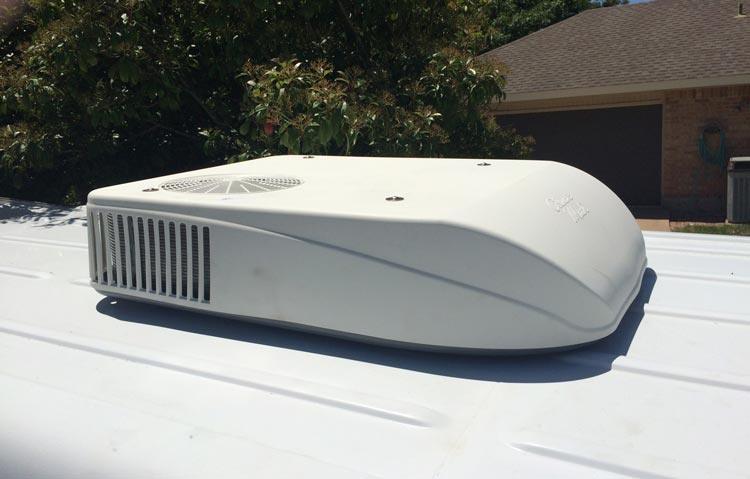
Air Conditioner for RVs on the Go
The name of these units implies the most significant advantage they provide. You won’t have to go through a lengthy installation procedure, and you can always remove the air conditioner and use it in other cars.
Portable air conditioners may be bought as a stand-alone option for smaller RVs, or to complement the cooling capability of an existing rooftop or window air conditioner in a bigger rig.
AC Units for RVs Under the Bench
Because they don’t hinder window views or limit natural light from skylights, these units are another effective option to rooftop and window AC units.
However, since hot air rises, they typically need more power to draw it down and out of your RV.
They do, however, have the advantage of being rather small, taking up very little room within your setup.
And, since they’re meant to be put under a bench seat or RV couch bed, you won’t even notice them once they’re in place.
However, some RV owners opt not to install this sort of air conditioner because they want to utilize the area beneath the bench for storage.
And after you’ve installed an AC unit in that space, you’ll need to maintain the area free so the unit can work as efficiently as possible.
Air Conditioner for Campers Without Ducts
Smaller RVs, cab-over campers, and camper vans are more likely to have non-ducted air conditioning.
This sort of unit does not enable you to regulate the distribution of cold air around your rig, which is important in bigger RVs, travel trailers, and 5th wheels.
Rather of using a ducted system, these devices blast air out of the unit itself.
The air then goes via vents that you may adjust manually to send the air to any portion of your RV’s cabin you like.
Because these units are usually put in the middle of your RV, they aren’t necessarily the greatest at evenly delivering air to the most forward and backward areas.
They do, however, have a lower price tag, and some of the finer types enable you to make thermostat changes from a distance.
The disadvantage of these units is that they tend to generate more noise than others.
RV Air Conditioner with Ducts
Ducted units are popular for longer rigs since they can disperse cool air more uniformly along the length of your RV, travel trailer, or 5th wheel.
They also enable you to better focus the delivery of cold air to various sections of your RV, based on the time of day and your particular preferences.
Ducted units work by circulating air via your RV’s existing ducting system.
The ducting system in your rig may be installed in the ceiling, floor, walls, or a mix of those three areas, depending on the exact design of your rig.
These units, unlike non-ducted systems, are meant to be plugged directly into your RV.
They’re also the greatest option for integrating your new air conditioner with your RV’s thermostat.
And you’ll be able to specify the temperature at which your air conditioner will switch on automatically as a result of this.
A ducted unit also has the advantage of being able to be installed in multiples and operated in combination with one another.
For longer setups, this is especially crucial since a single AC unit may not be strong enough to chill the whole room.
Furthermore, having a second unit enables you to tailor the temperature in various sections of your RV instead of having to settle with a single set of temperatures throughout.
RV Air Conditioner Design: Low Profile vs. Full Height
When comparing various RV air conditioners, you’ll also have to decide if you want a low-profile or full-height one.
Low-profile designs, as you would expect, are smaller and more aerodynamic.
If you drive your rig regularly and saving money on gas is important to you, a low-profile air conditioner is the way to go.
Low-profile units are also more compact and lighter than full-height ones. As a result, they minimize drag while driving and may need a smaller cut-out in the roof of your RV during installation.
A low-profile unit also adds less height to your RV’s total height, giving you greater clearance and lowering the chance of colliding with low bridges or underpasses.
If your setup is already on the tall side, a low-profile unit is a must-have.
Having said that, low-profile RV air conditioners are often louder than their full-height equivalents.
If you have a smaller trailer and are more worried about annoying your RV park neighbors than improving your fuel efficiency, a full-height RC AC unit is the way to go.
Your RV or camper’s air conditioner’s energy efficiency
Finding a more energy-efficient air conditioner can save you money in the long run since it will use less watts while operating.
This may also help your RV’s batteries and generator last longer. It may also enable you to utilize other appliances at the same time in certain circumstances.
The difficulty with high-wattage AC units is that you’ll almost certainly need to use your generator to power them.
And most RV generators use some kind of gas to provide the necessary electricity for your air conditioner to run.
Because gas is expensive, it stands to reason that an RV air conditioner with a lower wattage will need your generator to use less fuel to operate it.
At the same time, you may be able to switch on other RV equipment while your AC is operating without blowing a fuse or tripping a breaker.
These are all good reasons to invest in an energy-efficient RV air conditioner. But how can you estimate how much electricity an AC unit would use before you purchase it?
The good news is that most RV air conditioner manufacturers will include the needed starting and operating wattages for their devices.
However, we’ll provide you with some typical values to work with:
A 7,000 BTU air conditioner takes 1,700 beginning watts and 600 operating watts to operate.
A 10,000 BTU air conditioner takes around 2,000 beginning watts and 700 operating watts to operate.
A 13,500 BTU air conditioner takes around 2,750 beginning watts and 1,250 operating watts to operate.
About 3,500 beginning watts and 1,500 operating watts are required for a 15,000 BTU air conditioner.
Recommended reading: Solar Power for RV Air Conditioner: Is It Possible?
Capacity of cooling (BTUs)
Some people refer to the cooling capacity of an RV air conditioner when they speak about its size. The cooling capacity of an air conditioner is usually measured in British Thermal Units (BTUs).
The BTU rating of an air conditioner will inform you whether it has adequate cooling capability for the amount of space within your RV.
Simply double your rig’s length by its breadth to obtain an approximation of its square footage, and you’ll have a good starting point.
Then you’ll need to figure out how the BTU rating translates to cooling capacity over a certain area.
However, as you may already guess, a greater BTU rating corresponds to more cooling capacity.
In general, most AC systems with a BTU rating of 5,000 to 7,000 will be able to cool a 100 to 300 square foot RV adequately.
Units with BTU values of 8,000 to 12,000 should be able to effectively chill a 300 to 550 square foot RV.
The most powerful units, with BTU levels ranging from 14,000 to 18,000, are best for rooms ranging from 550 to 1,000 square feet.
Keep in mind that when it comes to an AC unit’s BTU rating, there is such a thing as overkill.
As these ratings rise, so does the unit’s energy usage (typically). You may even acquire two smaller air conditioners to adequately cool a bigger RV.
In certain circumstances, this might actually be more energy-efficient than buying a device with a high BTU rating.
Installation Ease
Before you make your final decision, think about how easy it will be to install your new RV air conditioner.
What you’re comfortable with will ultimately be determined by your abilities and amount of personal experience.
Portable air conditioners, as you would expect, are the simplest to set up. Simply decide where you’d want to put it and make sure there’s a suitable power outlet nearby.
The most pressing worry with this sort of air conditioner is where you’ll properly store it while your RV is in motion.
Window air conditioners are extremely simple to install since they often come with all of the required gear to place them safely and securely in any window of your RV.
However, since you won’t be allowed to drive with one of these units protruding from your RV window, you may have to repeat the installation procedure if you pick this sort of RV air conditioning.
Because of their position, under-bench units need a little more complicated installation.
They must also be vented to the outside of your RV, and installing this sort of AC unit may be made more difficult by the fact that you’ll be laying, kneeling, or sitting down to work in the area where your AC unit is being installed.
The rooftop air conditioner wins the distinction for the most time-consuming installation method.
These devices are normally sold in two sections, one for the roof and the other for the inside ceiling of your RV.
These components are then wired together at the last minute before the complete device is linked to your RV’s electrical system.
Because these units are frequently designed to connect to your RV’s thermostat, they may need a little more wiring than other kinds of RV AC systems.
If you do everything correctly, the installation of rooftop air conditioners should be a one-time job.
As a result, unlike some other kinds of RV AC units, you won’t have to worry about moving it about, storing it while your RV is in motion, or reinstalling it when you arrive to a new site.
Recommended reading: How to Use an RV Air Conditioner (With 5 tips for trouble-free use)
Output of Noise
To be honest, finding an RV air conditioner that creates zero noise will be difficult.
However, some models are noticeably quieter than others. So, if you’re sensitive to AC noise or concerned that it will be too noisy for your RV park neighbors, you’ll want to look for the quietest AC unit available.
AC units, in general, may create a broad variety of noise levels. The majority of units will fall between 37 and 82 decibels, however this allows a lot of leeway for interpretation.
Consider that a regular discussion between two people usually takes place at a decibel level of 40 to 60.
If reducing the noise output of your air conditioner is more important to you than its total cooling capability, search for a device with a noise output of 40 to 60 decibels.
The good news is that there are a few things you can do after you purchase an AC unit to reduce its noise output, such as wrapping it in noise-reducing materials like rubber after it’s installed.
As a result, you’ll be able to place cooling capacity or power consumption first, and then worry about noise output afterwards.
Extra Capabilities
Some air conditioners are capable of doing more than just cooling your RV. Some come with condensate pumps, heat pumps, and air filtering systems, for example.
These capabilities enable a single-purpose air conditioner to perform several functions in your RV area.
For example, an air conditioner with an integrated heat pump will assist you in weathering year-round conditions in your RV while also assisting you in heating the room when temperatures drop.
Some RV air conditioners also include an air filtering system. These devices enhance the air quality within your RV by removing smoke, dust, CFCs, and other potentially dangerous particles from the air.
So, if breathing clean air is a top concern for you (and it should be, according to us! ), we recommend investing in an air conditioner with a built-in air filtering system.
Finally, some RV air conditioners have a built-in condensate pump. This pump is used to drain surplus water from the AC unit and may also assist to lower the humidity level in your RV.
This sort of pump is required for rooftop AC systems unless you want to regularly climb your RV ladder to drain extra water that accumulates in your AC unit.
So, which RV air conditioner is the best?
We picked the Dometic Brisk II Rooftop AC as the best overall RV air conditioner because it has one of the highest BTU ratings in the business, allowing it to cool even the biggest RVs, travel trailers, or 5th wheels.
It’s also adaptable enough to work with ducted or non-ducted ventilation systems on RVs.
The Honeywell MN12CESBB Portable AC unit is a good alternative for those looking for a portable solution for smaller rigs or to augment your current rooftop AC unit.
This is the only unit on our list that you can move about within your RV to your favorite spot, and it’s tiny enough to fit in camper vans and cab-over campers.
Frequently Asked Questions About RV Air Conditioners
You’ll need to know how to remove the old AC, install the new one, and connect it to electricity to finish the process of installing a new RV air conditioner in your trailer.
In our commonly asked questions regarding RV AC units section, we’ll address these (and a few more!) inquiries.
How Does An RV Air Conditioner Work?
Alternating current, which is normally provided by your RV’s generator or shore power (i.e. when you’re hooked into a power stand at a campsite), is used by almost all RV air conditioners.
Most of these AV systems can’t be powered by your RV batteries or solar panels since they need so much electricity.
The mechanics of how they operate vary depending on the sort of air conditioner you’re looking at.
All RV air conditioners, on the other hand, draw heat from your trailer and put it outdoors. This may be in contrast to how you feel when your air conditioner is on.
It may seem that your air conditioner is pushing cool air into your unit at times.
However, removing hot air from a room to cool it down is considerably simpler than bringing cold air in from the outside.
This is particularly true in hot climes, and it is also how RV air conditioners function.
What Is The Best Way To Maintain An RV’s Air Conditioning?
The easiest approach to keep an RV air conditioner in good working order is to use it sparingly and clean it properly every other season.
Another crucial maintenance advice is to be aware of rainstorms, hail, UV rays, and other falling debris that might harm your AC unit in between cleanings.
It’s usually a good idea to invest in an RV AC cover if you’re going to be leaving your AC unit unattended for many weeks or months at a time. This will prevent your unit from getting damaged while you’re not around.
Using an RV AC cover also reduces the risk of leaks or incursions, which might result in further damage to your RV’s interior or ceiling.
This is particularly crucial if you’re going to be away from your rig for an extended period of time and won’t be able to fix any leaks or incursions that occur.
How Long Does An RV’s Air Conditioner Last?
This will certainly depend on how often you use your RV’s air conditioning and how well you maintain it.
In short, most of the best RV air conditioners will last between five and ten years.
Some may last even longer if used infrequently and properly maintained.
Frequency of use, outside air temperatures when the AC is in use, and the initial construction quality of the AC unit you purchase are the major factors that will determine the lifespan of an RV AC unit.
What Size RV Air Conditioner Do I Need?
When we speak about the “size” of an RV air conditioner, we typically mean the cooling capacity or the amount of energy it consumes each hour.
The amount of energy used is commonly measured in British Thermal Units (BTUs), which we discussed in further depth in our Buying Guide.
Having said that, the simplest approach to figure out what size RV air conditioner you need is to measure the square footage of your RV.
And, depending on the size of your RV, here’s a short breakdown of the BTUs you should look for:
A 5,000 to 7,000 BTU air conditioner is required for 100 to 300 square feet.
Between 8,000 and 12,000 BTUs are required for an air conditioner in a space of 300 to 550 square feet.
Between 14,000 and 18,000 BTUs are required for a space of 550 to 1,000 square feet.
What Is The Best Way To Install An RV Air Conditioner?
Obviously, the method varies based on the model of RV air conditioner in question.
Portable air conditioners, on the other hand, don’t need any setup (other than being plugged in), and window air conditioners simply fit into the appropriate size window at your desired position.
As you would expect, under-bench units are also quite simple to install, therefore we’ll concentrate our response on the most difficult sort of AC unit to install: the rooftop AC unit.
To begin, check sure your present air conditioner is turned off. This entails disconnecting the unit’s power source and flicking the appropriate switch on your RV’s breaker box.
You won’t have to bother about choosing a spot for your new AC unit if you’re merely replacing your old one with a new one.
If you’re installing a brand-new unit, you’ll need to choose a place first and then cut a hole in your RV’s roof.
While I don’t advocate doing this unless you have some building expertise, the most important thing to remember about this step is that your new unit should be at least eight inches away from the corners of your RV’s roof.
You’ll also want to make sure the hole you cut is big enough to accommodate the connections between the roof and the ceiling parts of the unit.
However, before cutting a hole in your RV’s roof, I’d suggest consulting an expert.
https://youtu.be/Rnsq8H2bYmM
If you’re only replacing an old unit with a new one, start by unscrewing and removing the roof shroud, then unscrew the bigger bolts that hold the AC unit in place.
You may then disconnect the ceiling and roof sections of your old air conditioner and remove them from your RV.
Then you may begin by putting your RV’s roof section over the hole in the roof.
Install the unit using the mounting bolts provided, and then return to your RV.
Install the ceiling component of the AC unit and attach it in position with the second set of mounting bolts once inside.
Now is the time to return to your roof and apply sealant to the locations where the mounting bolts make contact with the roof material.
This will assist to waterproof these mounting areas as well as provide the overall AC unit additional stability.
Finally, depending on the wire color, you’ll need to return inside and correctly wire the ceiling unit.
Then, reconnect the power supply and plug the ceiling unit into the roof unit to ensure that everything is working correctly.
Again, if you don’t have much expertise dealing with electrical connections, we suggest enlisting the help of a professional.
How Do You Recharge An RV’s Air Conditioner?
Some RV rooftop air conditioners must be charged before they can function properly. Additionally, older air conditioners may need recharging in order to continue to function properly.
This is due to the fact that these units normally employ a refrigerant that must be filled to a particular level in order for the AC unit to operate at optimal efficiency.
It’s time to recharge your camper A/C unit when the refrigerant level falls below the acceptable capacity.
To do so, first turn off the electricity to your AC unit by turning off the electrical breaker on the circuit panel box of your RV.
Then you must locate the refrigerant you purchased (and hope you purchased the correct one!).
Consult the device’s instruction booklet to ensure you choose the correct refrigerant for your AC unit.
With the correct refrigerant in hand, use a socket wrench to climb up onto the roof.
You may need many wrenches of various sizes to do the work, so pack more than you think you’ll need to prevent climbing up and down your RV ladder several times.
Remove the shroud screws surrounding the lid of your AC unit while you’re on the roof, then gently remove the lid.
Lift the lid as straight as possible to avoid damaging it throughout the procedure.
Remove the lid and inspect the refrigerant gauge. This will tell you how much refrigerant you’ll need to refresh your air conditioner.
Then unscrew the port and fill it with the required quantity of RV refrigerant.
Because you’ll want to notice the difference between the air temps within the unit and inside your RV multiple times throughout this procedure, you should add your refrigerant gently.
When you’ve reached the proper amount of refrigerant, the temperature differential between the interior of your RV and the temperature in the AC unit should be about 20 degrees Fahrenheit.
Before replacing the lid and fastening it, return the AC unit’s power supply and check the temperature inside your RV for several minutes to confirm that it has been properly recharged.
Conclusion
If you’re a full-time RVer, you won’t be able to stay in your trailer all year if your air conditioner isn’t working.
Even if you only travel in your RV sometimes, the ability to chill the air inside will make your journeys much more pleasant.
While not all residences (depending on location) have both central heat and air conditioning, RVs need both features since they are built to allow you to live in a variety of climates over the course of a single calendar year.
As a result, we hope you found our evaluations of the top RV air conditioners to be helpful. In our Buying Guide section, we also sought to give useful ideas on how to buy a new RV AC, so we wish you the best of success replacing or upgrading your RV AC unit!


